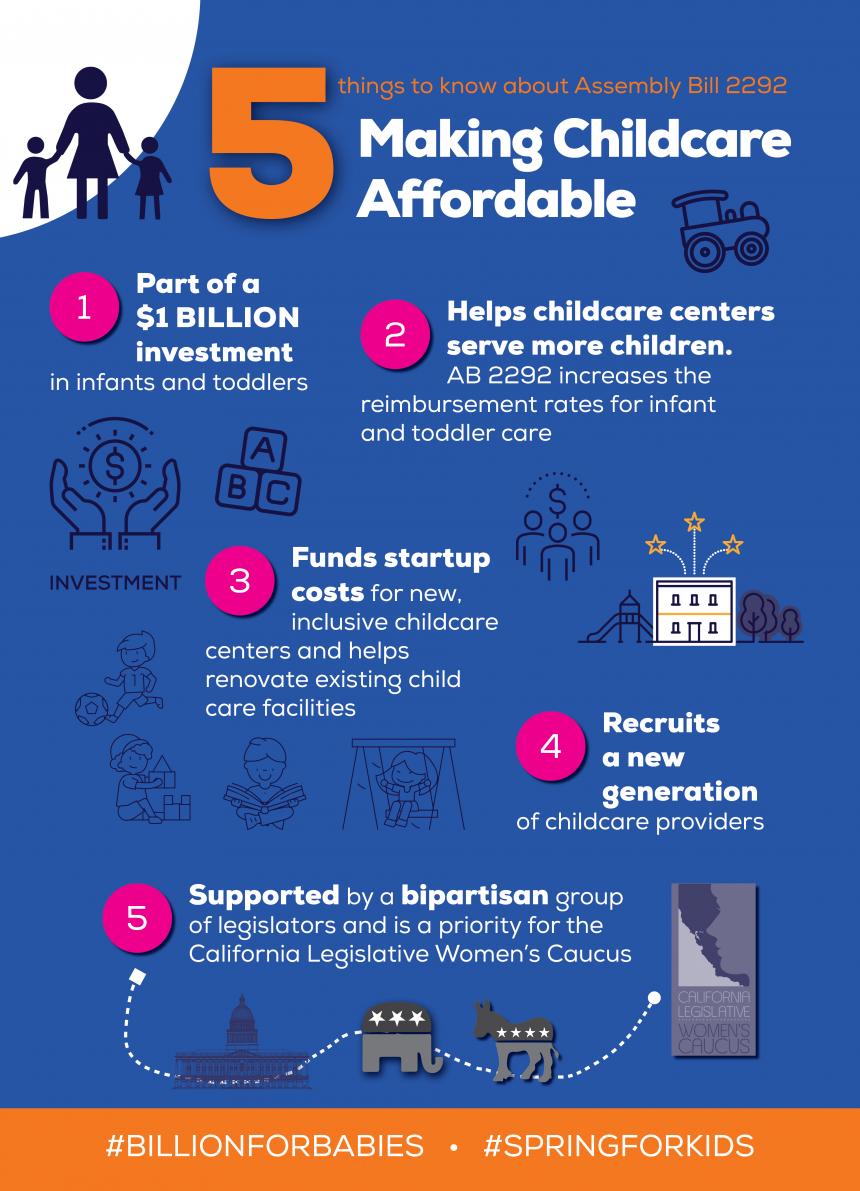
SUMMARY
Assembly Bill 2292 will strategically invest in California's child care system by increasing state rates for infant and toddler care, creating a grant program to fund implementation and start- up costs of new child care facilities, and establishing a fund to recruit a new generation of family child care providers.
BACKGROUND
Well-established research demonstrates that the first three years of a child's life are critical to a child's positive brain development and future. Assuming normal development, a healthy baby will be born with 100 billion neurons, nearly twice as many neurons as adults, in a brain that’s half the size. While brain volume will double by age three, not all of those neurons will stick around; synaptic pruning takes place as a baby ages, in which the brain gets rid of weaker synaptic connections in favor of stronger ones. Parents need access to high quality child care that promotes their child's healthy development and learning while they work--especially in the first years of a child's life.
California currently has two subsidized child care programs to help non-CalWORKS, working-poor families with babies find affordable child care. Subsidized child care providers are paid through either 1) direct contracts with the California Department of Education (CDE) or 2) vouchers through the Alternative Payment Program.
Direct Contractors receive funding from the state at a Standard Reimbursement Rate, which pays the same rates throughout the state, while Alternative Payment Programs reimburse care providers based on the Regional Market Rate (RMR), which is tied to the cost of care in each county.
The Standard Reimbursement Rate is exceptionally low and inadequate to fully fund high quality child care and development programs. Less than 14 percent of eligible infants and toddlers have access to subsidized care. Community agencies and school districts have long lost money, especially in infant and/or toddler classrooms. As a result, many agencies across California have closed infant and toddler classrooms and there is little or no ability to open new infant or toddler child care classrooms.
There is a specific problem in the Education Code that leads to the exceptionally low reimbursement rates. Center contractors are using a system similar to K-12 “ADA”, called a standard maximum payment rate (currently $45.44 per day of enrollment). Infant and toddler classes cost much more per child to operate, due largely to the much smaller teacher or adult to child ratios required. Therefore, there are “adjustment factors” to increase the standard maximum payment rate for infants and toddlers. The current adjustment factors are not enough to cover the significantly higher costs of infant and toddler centers. The current adjustment factors are 1.7 for infants (0 to 18 months) and 1.4 for toddlers (18 to 36 months).
In addition to the adjustment factors, there is also a need for new and updated state preschool program classrooms and centers. However, the cost associated with opening these new facilities often deters them from happening, further contributing to the shortage of care.
For California’s working families with or without state-supported child care programs, access to licensed Family Child Care is critical to their ability to maintain employment. This is especially true for the parents of infants and toddlers, those who work in jobs meeting the demands of our 24/7 economy, and those in rural communities. Since 2008, California has seen a 26% drop in the number of licensed family child care homes leaving only 27,500 of these small businesses open in the state.
THIS BILL
AB 2292 by Assemblymember Aguiar-Curry will increase the state's capacity to serve babies and toddlers in our diverse, mixed-delivery child care system.
This bill will improve access to quality infant and toddler in California by increasing the adjustment factors for the Standard Reimbursement Rate. The new adjustment factors will be 2.1 for infants and 1.7 for toddlers. These new factors are based directly on the recommendations of the American Institute of Research, for the adjustment factor necessary to meet California's current infant/toddler care requirements.
AB 2292 will also create the “Classroom Planning and Implementation Grant Program” to fund start- up costs for opening new state preschool classrooms, and child care centers, as well as converting existing classrooms to serve a younger age group. The program will enable child care providers to purchase age-appropriate facilities and infrastructure, start-up support, and professional development for all care settings. Proper training, facilities, and infrastructure will ensure our infants and toddlers receive the best adult-child interaction to support their brain development when they are away from their parents. Those interested may apply to the Superintendent of Public Instruction, who is responsible for administrating the grant.
AB 2292 will also codify and expand the “Family Child Care Recruitment and Training Fund,” dedicating $6 Million dollars over 5 years to targeted outreach, recruitment, training, supplies, and resources for startup costs to recruit a new generation of family child care providers in California.
SPONSORS
Child Care and Development Administrators Association
Nina Buthee (415) 948-8858 Child Care Resource Center
Donna Sneeringer (916) 715-0575
First 5 California
Erin Gabel (916) 708-8895
CONTACT
Puja Navaney | Assembly Fellow Puja.Navaney@asm.ca.gov | (916) 319-2004
